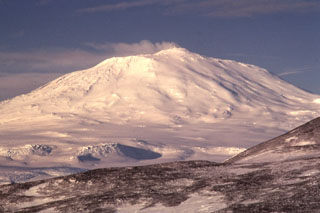Report on Erebus (Antarctica) — March 1990
Bulletin of the Global Volcanism Network, vol. 15, no. 3 (March 1990)
Managing Editor: Lindsay McClelland.
Erebus (Antarctica) Occasional Strombolian explosions from two small lava lakes; stronger SO2emission
Please cite this report as:
Global Volcanism Program, 1990. Report on Erebus (Antarctica) (McClelland, L., ed.). Bulletin of the Global Volcanism Network, 15:3. Smithsonian Institution. https://doi.org/10.5479/si.GVP.BGVN199003-390020
Erebus
Antarctica
77.53°S, 167.17°E; summit elev. 3794 m
All times are local (unless otherwise noted)
Scientists visited the summit of Mt. Erebus several times from mid-November 1989 through mid-January 1990. Activity was at a low level compared to that of the early 1980s. Anorthoclase phonolite lava in the summit inner crater was mainly confined to two small convecting lakes; one circular and about 20 m in diameter, and the other irregular and ~20 m long. This was the largest area of convecting lava seen at Mt. Erebus since late 1984, when eruptions buried an older, larger, lava lake system. Three hornitos were actively degassing around the lava lakes, and small fumaroles were present within the inner crater.
From mid-November to mid-December, infrequent small Strombolian explosions ejected bombs to a few tens of meters from the lava lakes. A small gas bubble burst was observed in one of the hornitos. In mid-December, an increase in the frequency and size of small Strombolian eruptions was recorded by Victoria University's remote video camera mounted on the crater rim 220 m above the lava lakes. Images transmitted to Scott base, 35 km from the volcano, showed bombs being ejected to more than 100 m height.
SO2 emission, monitored by COSPEC, has increased substantially over the previous 5 years, commonly exceeding 100 t/d. This increase was consistent with previous observations suggesting that the surface area of the lava lakes correlates with SO2 emission rates.
Geological Summary. Mount Erebus, the world's southernmost historically active volcano, overlooks the McMurdo research station on Ross Island. It is the largest of three major volcanoes forming the crudely triangular Ross Island. The summit of the dominantly phonolitic volcano has been modified by one or two generations of caldera formation. A summit plateau at about 3,200 m elevation marks the rim of the youngest caldera, which formed during the late-Pleistocene and within which the modern cone was constructed. An elliptical 500 x 600 m wide, 110-m-deep crater truncates the summit and contains an active lava lake within a 250-m-wide, 100-m-deep inner crater; other lava lakes are sometimes present. The glacier-covered volcano was erupting when first sighted by Captain James Ross in 1841. Continuous lava-lake activity with minor explosions, punctuated by occasional larger Strombolian explosions that eject bombs onto the crater rim, has been documented since 1972, but has probably been occurring for much of the volcano's recent history.
Information Contacts: P. Kyle and W. McIntosh, New Mexico Institute of Mining and Technology; R. Dibble, Victoria Univ.

